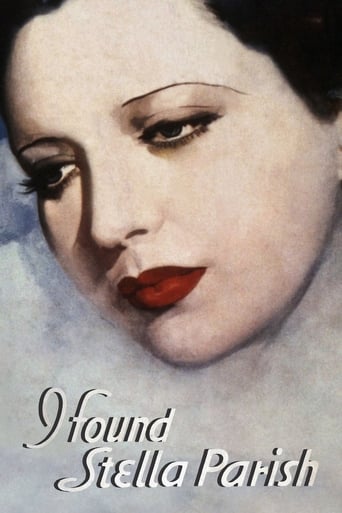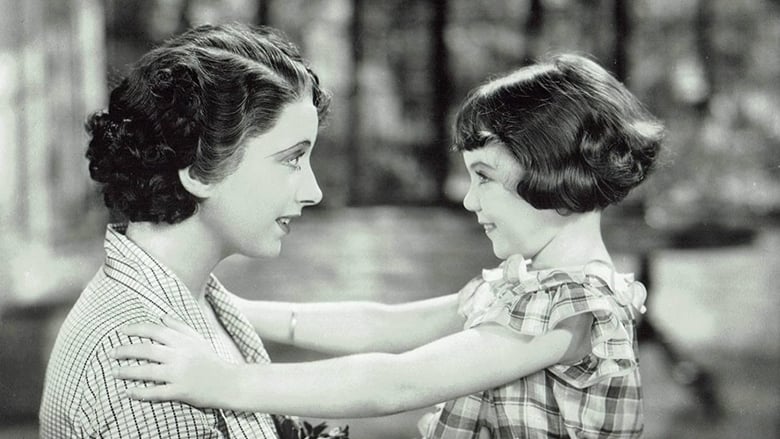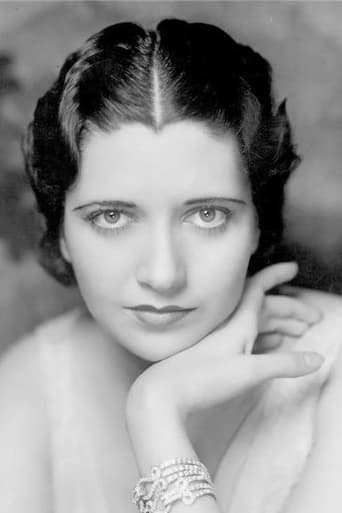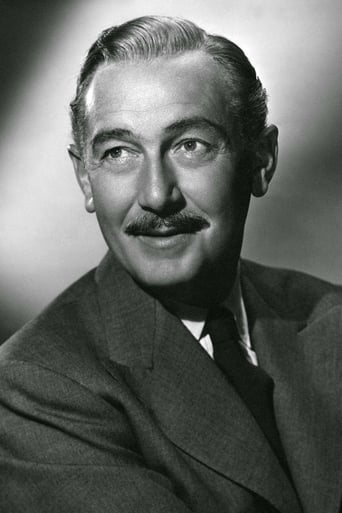

I Found Stella Parish (1935)
A blackmailer preys on an actress who is trying to protect her daughter from her past.
Watch Trailer
Cast
Similar titles



Reviews
Although I seem to have had higher expectations than I thought, the movie is super entertaining.
Strong acting helps the film overcome an uncertain premise and create characters that hold our attention absolutely.
A terrific literary drama and character piece that shows how the process of creating art can be seen differently by those doing it and those looking at it from the outside.
The film never slows down or bores, plunging from one harrowing sequence to the next.
I can't wait to be forgotten, Kay Francis once said, and as it inches closer to the 50th anniversary of her death, she is about as forgotten as another great star who also died the same year: Judy Garland. Only three years later, Liza Minnelli exclaimed in "Cabaret", "I feel just like Kay Francis!" It took decades for her re- discovery, but she has gained a true cult following as her glamorous image was captured by two books and constant showings of her movies on TCM. During the VHS era, only a handful of her films were available. Now through the TCM and Universal archives, they are slowly all coming out, and this soap opera is one of her best.As the Tallulah Bankhead of the fictional London stage, Stella Parrish is an American actress who is highly in demand, winning the love of her manager, Paul Lukas, and gaining the admiration from afar of journalist Ian Hunter. When she is visited by a mysterious man on opening night of what could be her greatest hit, Stella vanishes with her young daughter and companion, hiding in disguise and eventually befriending the suspicious Hunter. When the truth comes out, she becomes a temporary headline freak and makes a drastic decision to protect the young moppet, Sybil Jason.Francis shares the acting honors with vinegary Jessie Ralph, delightful as her tough but loving companion. Lukas and Hunter are decent, and while Jason can be cloying at times, something tells me that she had the women's audiences in tears. In fact, the film opens with Jason singing a cute little ditty imitating animal sounds that either had the audiences in hysterics, cooing over how adorable she was, or cringing over how cute they assumed she thought that she was. The play within the movie is set in Caligula's Rome and was almost concurrent with the unfinished "I Claudius". Unbilled Barton MacLane's voice is heard as the unseen mysterious man but instantly recognized. Certainly, there are some plot defects, but that doesn't seem to matter under Kay's emotional performance and the direction of Mervyn LeRoy. This was a huge smash for Kay, only surpassed just two years later by the emotional brilliance of " Confession". While some audiences might find it hard to believe that Kay could be considered a great star of the stage, that's exactly where she got her training and exactly where she returned to when her film career began to dry up. The conclusion has the emotional power of Vicki Lester's final line in "A Star is Born".
First: Let's begin with a quote from "Midnight Mass," an unpublished poem of mine (all rights reserved): (sorrry for the /s - there is a space limit here, and I have still more to say) - "What would the ancients have thought,/seeing the porcine wavering supports/of Saint Peter's canopy?//The seduction of Babylonia?/The wail of the Pharoahs?/The shimmy-shimmy of the two-buck dancer/caught on celluloid in '33, before the Code?//Sex and idolatry,/purple protuberances massing to the sky/are not what TV sees,/whether panning to the flowers in English,/or in Spanish mooning the faithful.//Both handed the lie by those serpentine columns, who say not truth not science,/but Hollywood excess begins here—/name dropping,/and the eternal celebrity of sainthood.//Though stars and saints come and go:/dropping from the firmament/like Kay Francis or St. Christopher."Now isn't that a fine way to capture how Bette and Joan live and Kay doesn't? Life is inherently unfair and Kay knew it, always knew it, and in every performance knew that she was only as good as her last sale, and that there would be a last sale. No NE flinty will-to-survive like Bette, or pure white-trash-cum-French-(don't forget LeSueur) glamour like Joan: no Kay was always pure "noble glamour," and always with the understanding that while nobility is eternal, glamour almost always passes with youth (that's why Joan is so pathetic, she willed her glamour to survive, and paid a ghastly price for it), especially for a woman, as her hips widen no matter what she does, and she slowly pirouettes into middle age and and the inevitable desuetude of barrenness. (Oh and Ruth Chatterton needs a place, too, but not here.)I like to think of Kay in the 1960s, her 60s too, as she faced her imminent young death (63 is young to me) from too many cigarettes and neglect. Was she able to rewatch her glamour-turns from the pre-code era, especially, "Trouble in Paradise," with her perfect American foil of Marian Hopkins? So that Americans could compare and contrast nobility with commercial will-to-live (yes Marian does the NE better than Bette, but that's another review)?In the end, nobility must reconcile with commercial survival, as the Italians learned so difficultly (but they have learned it, yea!). And Kay always knew that, was always commercial in her nobility, but she couldn't stop her own aging, nor could she stop the changing mores of that "low dishonest decade," where the Democrats, with their new power, enforced their own version of 1930s fascism on American popular culture.So if the other critics are right, and this is the first (and last?) Kay Francis hit "post-code," then the plot makes perfect sense, but I am not going to give any spoilers.I never watch Robert Osborne's intros until after the movie is over, where he sometimes gives a coda as well. He does both with this movie, and he makes fun of it in both the intro and coda as only "rich liberals" can do, which you know Osborne is(though not so rich I would guess, but in his 80s, he has enough to keep him going, so who cares?). So diss him here. And while I agree that Kay could have had a more butch male interest, Ian Hunter has enough "male beauty" to make her attraction believable, especially in the one scene where he briefly shows up in two-toned (with one tone white) shoes - I am sure there is a name for these 30s-specials (are they still called spectators when men wear them?), but anyway, he functions as a classy Brit silly enough to fall in love with an aging star.For Kay is aging - now 30, which for a woman in the aptly named decade, meant she was approaching the third movement of the "Mary Astor dance" ("Who is Mary Astory? Get me Mary Astor. Get me a Mary Astor type. Who was Mary Astor?"). She knows 1937 is coming, and she knows she won't get to say, in 1950, "I am big. It's the pictures that got small," because her story is more complicated than Gloria Swanson's - that quintessential Protestant girl gone big time, where she could always argue she hadn't gone bad (in the best Protestant female-empowering dialectic).Swanson had no time for nobility - there was too much life to be lived, and she knew that in la coda nobilitas (someone check my Latin here, I'm winging it), la dama always gets screwed in the end. And maybe la dama wants it - vagina dentata and all that for some more Latin. Who knows, who cares? maybe in another life I will be that sex, but now I just do it. So while Swanson deserves her immortality, with her apotheosis being Sunset Boulevard (every scene memorized, trust me, and I too, always wanted a swimming pool- still not there yet), Francis needs to break into 21st-century post-modern popular culture, because she taught Americans the lesson, now lost, about Roman Catholic nobility.Another review will need to riff on that theme, for IMDb is shutting me down, but let's end where I began - I cried like a baby, the plot is believable, and while not as great as her pre-code movies, this is a great movie, better than anything Bette or Joan ever did, and another example of why Kay needs to get her long overdue place in the pantheon.
I Found Stella Parish masterfully engages the viewer. It is very stylized hokum, but yet it is sincere and rather poignant. Kay Francis plays an actress with a secret past that involves having given birth to a child out of wedlock. Taking a break from her stage career, she decides to focus on her role as a mother and travels incognito with her daughter, played by Sybil Jason. It's a nice bit of casting, and their performances nicely complement each other.Three years later, Warners would reunite Francis and Jason on screen in Comet Over Broadway. Once again, they are mother and daughter, and once again Miss Francis is an actress.
Lots of people seem to have negative things to say about this old film, but you have to remember when you watch it that Kay Francis was the consummate precode actress. When the production code began to be enforced in 1934, Warner Brothers had to struggle to find the right vehicles for Kay that would also not violate the code. Although this is not the best work she did before Jack Warner threw her and her career under the bus in 1937, it is a solid little film.Kay plays successful American stage actress Stella Parish living in England. Stella lives a quiet life with her daughter, and refuses to be interviewed by the press or have any photo taken of her that is not a publicity still with her in full makeup for whatever role she is playing. One night, after a performance, someone who recognizes her from "her old days" waits for her in her dressing room and attempts to blackmail her. Stella reacts by fleeing England in the dead of night, daughter in tow. Reporter Keith Lockridge (Ian Hunter) is on her trail looking for the story of his career. He finds that story - where Stella is now and who she really is as far as her past is concerned - but he also finds romance. Of course the whole time Keith is befriending Stella she has no idea he is a reporter. After he has already turned in his story to his editor, Stella comes to him, confesses that she considers him a trusted friend and more, and then tells him the story behind the facts he has put in his headline, all the time thinking he knows nothing of her past. Justifiably feeling like a heel, Keith tries to squash the story he has sent back to London, but it is too late - the story is already in the papers being sold on the streets. What did Stella do in her past to cause her to flee, and how will this pan out for everyone involved? Watch and find out.This is worth watching for the reason that most Kay Francis films are worth seeing - nobody suffers for her past sins and more-so the sins of others that have done her wrong like Kay Francis, and nobody looks that good while doing so. As for Ian Hunter, I really liked Kay best opposite William Powell and George Brent, and I thought Mr. Hunter was just a bit too bland to be paired with the glamorous Kay in most cases. This is one of the exceptions as he really plays the part of the reporter quite well. He doesn't play a Lee Tracy style journalist here. Instead he plays a classy man with a not so classy job who has to reconcile this with a pesky conscience that's finally beginning to bother him.What is bad about the film? For one thing, I've never been a huge Sybil Jason fan, and in this part as Stella's daughter she's just over the top sticky sweet. Also, the production values are thrown together. Someone has already mentioned the business of English cars with the steering on the left hand side as well as the odd play Kay is starring in that is supposed to be about ... Caligula??? I'd recommend this to anyone who likes Kay Francis and old films from the 30's, but do be advised there are more than a few holes in the plot and the art design.





